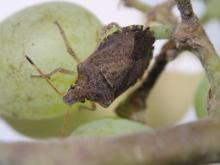Consperse stink bug (Euschistus conspersus) and other stink bug species
See also:
Brown Marmorated Stink Bug: An Emerging Threat to Pacific Northwest Agriculture
Pest description and crop damage Insects have piercing, sucking mouthparts and a triangle between the head and the wings. Feeding on fruit causes depressions and corky areas. Stink bugs are up to 0.5 inch in length and fairly broad with a shield-shaped appearance, the color can vary from green to brown. The most damaging stink bug in western orchards is the consperse stink bug. The adult is pale brown, yellow underneath with red antennae. Brown marmorated stink bug (BMSB) is characterized by white bands on the coal-colored antennae and legs; a distinct brown "marbled" color on the back that consists of flecks of different brown colors; red eyes; and an underside that may be cream, pink, red, yellow or green.
Biology and life history These insects overwinter as adults and may migrate into orchards around bloom. Stink bugs have a wide host range and will feed on many broadleaf weeds. As broadleaf weeds around orchards dry up during the summer, stink bugs may migrate into the orchard and feed on the fruit. BMSB adults overwinter in human structures including homes, shops and outbuildings. Rock outcrops, leaf litter, and dead standing timber may also be used as overwintering sites. BMSB move out from overwintering sites into orchards in the spring where they may begin to reproduce. They may also migrate in from forest or riparian borders, or other crops throughout the growing season.
Pest monitoring Monitoring by limb tapping can aid in detection but damage to fruit is often the first indication of their presence in the orchard.
Management-cultural control
Establishment and maintenance of a weed free orchard groundcover will deter stink bugs. Do not mow cover crops or weeds when stink bugs are present since mowing may cause bugs to disperse to the fruit trees. A sod groundcover that is mowed regularly will minimize stink bug activity within the orchard.
Management-chemical control: HOME USE
- azadirachtin (neem extract)-Products containing neem extract may be phytotoxic to some pear cultivars. Some formulations are OMRI-listed for organic use.
- carbaryl-Highly toxic to bees.
- gamma-cyhalothrin-Highly toxic to bees.
- imidicloprid-Highly toxic to bees. Soil drenches may have residual activity in woody plants lasting for 12 or more months. If short-term management is the goal, consider other approaches.
- insecticidal soap-May require several applications. Some formulations are OMRI-listed for organic use.
- kaolin clay-Applied as a spray to leaves, stems, and fruit, it acts as a repellant to some insect pests. Some formulations are OMRI-listed for organic use.
- lambda-cyhalothrin-Highly toxic to bees.
- permethrin-Highly toxic to bees.
- pyrethrins-Highly toxic to bees. Some formulations are OMRI-listed for organic use.
- zeta-cypermethrin-Highly toxic to bees.
Management-chemical control: COMMERCIAL USE
Growing-season sprays:
- bifenthrin (Brigade 2EC) at 2.6 to 12.8 fl oz/A. REI 12 hr. PHI 14 days. Do not exceed 32 fl oz/A per season. Use of pyrethroid insecticides during the growing season can disrupt naturally occurring biological control and may result in increased populations of some pests.
- clothianidin (Belay) at 4 to 6 fl oz/A. REI 12 hr. PHI 7 days. Do not exceed 12 fl oz/A per season. Repeated use may induce spider mite buildup.


